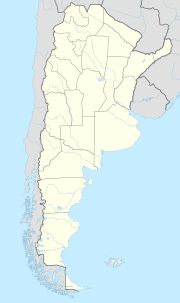Campo del Cielo
Campo del Cielo (Spanish field of the sky ) is the name of a field of impact craters in Argentina and the fragments of an iron meteorite found there .
history

Position of the scattering ellipse from Campo del Cielo in Argentina |
Parts of the Campo del Cielo meteorite were first discovered in 1576. The then Spanish governor Hernán Mexía de Miraval heard of indigenous indigenous traditions that iron had fallen from the sky. He then sent an expedition that brought several fragments. The site, an arid plain, was named "Piguem Nónaxá", translated by the conquistadores as Campo del Cielo (Field of Heaven). Around 200 years later, the Spaniards sent another expedition because it was suspected that some fragments contained silver . The reports of the Indians were not believed, however, because it was assumed that the origin of the metal was an ore mine. A naval lieutenant allegedly found a fragment that he estimated to be 15 to 18 tons. However, since examination of the material revealed that it was only iron, it was left behind. The fragment was not found again in later expeditions.
In 1992, an American meteorite dealer was temporarily arrested when he was trying to remove a 37-ton fragment - the heaviest ever found. The dealer had bought the meteorite from a local who claimed to be its owner. However, the Argentine authorities did not agree and the meteorite remained in the country.
In 2016, the largest fragment of Campo del Cielo ever recovered was excavated. It weighs just under 31 t. Since water ingresses during the excavations and the nearby community of Gancedo came to the rescue, it was decided to name the piece after her.
In total, more than 100 tons of meteorite material have been found so far. The larger fragments are found in and around an area of 26 craters. The largest crater has a diameter of 78 m and a depth of 5 m.
By examining wood that has been preserved near the crater, the age of the crater was determined using the radiocarbon method . According to this, the impact of the meteoroid should have occurred between 4000 and 6000 years ago.
The original small cosmic body came from the asteroid belt . Its remains are classified as Group IA coarse octahedrites . Chemical composition: 92.6% iron , 6.68% nickel , 0.43% cobalt , 0.25% phosphorus , 87 ppm gallium , 407 ppm germanium and 3.6 ppm iridium .
See also
literature
- Miguel Rubín de Celis: Philosophical Transactions of The Royal Society of London, Vol. 78 (1788), pp. 37-42.
- Antenor Alvarez: El Meteorito del Chaco. Buenos Aires: Peuser 1926.
- William Cassidy / Luisa M. Villar et al .: Meteorites and Craters of Campo del Cielo, Argentina. In: Science, Vol. 149, No. 3688 (1965), pp. 1055-1064.
- LO Giacomelli: Guía de meteoritos de la Argentina. In: Revista del Museo Argentino de Ciencias Naturales "Bernardino Rivadavia" 8/1 (1969).
- William Cassidy / M. Renard: Discovering research value in the Campo del Cielo, Argentina, meteorite craters. In: Meteoritics and Planetary Science 31 (1996), pp. 433-448.
- RG Liberman et al .: Campo del Cielo Iron Meteorite: Sample shielding and meteoroid's preatmospheric size. In: Meteoritics and Planetary Science 37 (2002), pp. 295-300.
Web links
- Campo del Cielo in the Earth Impact Database (English)
- campodelcielo.info (German, English, Spanish)
Individual evidence
- ↑ Thyssen Bornemisza Art Contemporary ephemeropteræ 2017 / # 9 - Guillermo Faivovich and Nicolás Goldberg , accessed on February 3, 2019.
- ↑ Second largest meteorite discovered in the world (foxnews.com) 2nd largest meteorite in world weighing nearly 68k pounds , accessed on November 30, 2019.

